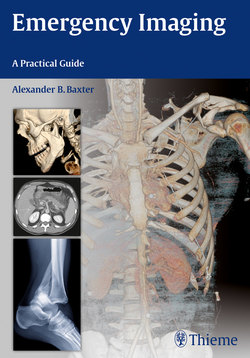Читать книгу Emergency Imaging - Alexander B. Baxter - Страница 35
На сайте Литреса книга снята с продажи.
Оглавление21
2Brain
num, mastoid ecchymosis (“Battle sign”), facial nerve palsy, vertigo, tinnitus, and conductive or sensorineural hearing loss. Fractures through the clivus can injure the sixth cranial nerve. Posterior skull base fractures can injure the dural venous si-nuses, resulting in posterior fossa epidural hematoma or dural sinus thrombosis and venous infarct. If the fracture extends to the occipital condyles, it can lead to cranio-cervical instability.
Most skull base fractures are identified on noncontrast head CT obtained for evalu-ation of head trauma. High-energy impact and fractures that traverse the carotid ca-nals or cavernous sinus can be associated with carotid or vertebral injury, including dissection and pseudoaneurysm. Vascular injury places the patient at increased risk for secondary embolic cerebral infarct, which can be prevented with anticoagula-tion. Because of this risk, CT angiography with helical thin-section imaging is gener-ally advised in this group (Fig. 2.5).
◆Skull Fracture
A calvarial fracture does not reliably pre-dict underlying brain injury, and a normal skull radiograph does not exclude intra-cranial injury. Calvarial fractures that are depressed more than 5 mm are usually elevated surgically. Epidural hematoma is associated with fractures that traverse the course of the middle meningeal artery. Skull base fractures are associated with high-energy trauma and with more severe brain injury; the most common locations include the petrous temporal bone, the ba-siocciput, the sphenoid bone, and the eth-moid bone.
Anterior skull base fractures traverse the paranasal sinuses and orbit, and they can disrupt the cribriform plate and optic canals. Clinical consequences include CSF rhinorrhea, periorbital ecchymosis (“rac-coon eyes”), and olfactory or optic nerve damage. Trauma to the central skull base, usually from lateral impact, results in pe-trous temporal bone fractures and may be associated with CSF otorrhea, hemotympa-
Fig. 2.5a–da,b Calvarial fracture. Left frontal calvarial fracture with small subjacent epidural hematoma and minimal intracranial air. The fracture fragment is elevated one-half calvarial width relative to the remainder of the skull.
c,d Skull base fracture. Nondisplaced longitudinal right temporal bone fracture that traverses the basi-sphenoid (clivus) and basiocciput. Blood is present in the sphenoid sinus and the right mastoid air cells. A small amount of air is present in the posterior fossa.
e,f Depressed skull fracture. Right parietal calvarial fracture with 1.8-cm depression and subjacent corti-cal contusion.
